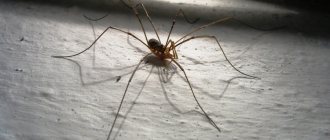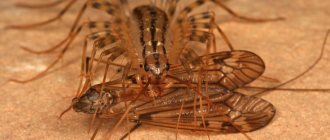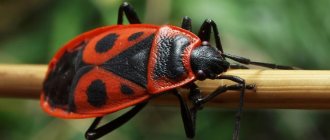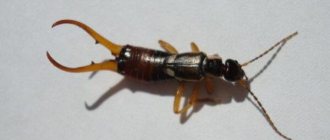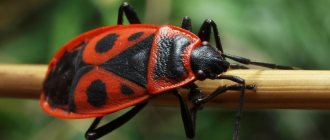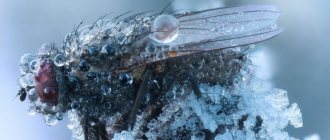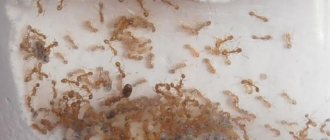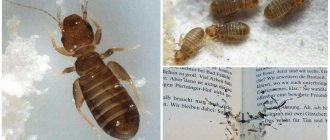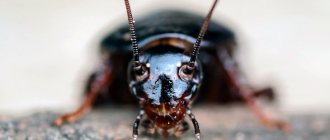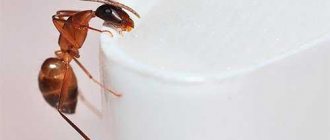Throughout life, the human home attracts many insects, since they can hide in it, spend the winter and find something to eat. At the same time, there is the appearance of many, sometimes dangerous insects, the proximity of which does not bode well. As for the centipede, it is the most harmless creature that can be found in a person’s home. Moreover, such a neighborhood can bring a positive effect, although few people know about it.
Therefore, first of all, the centipede scares apartment residents with its not very attractive appearance: the body is long and sinuous with many legs. Fear arises because practically no one knows what kind of insect this is and what to do with it. This article explains what this insect is and how to deal with it.
What does a centipede look like, does it bite, is it dangerous or not?
Centipede, or flytrap
The centipede actually does not have 40 legs, but only 30. And it is not an insect, as we used to think, but belongs to the genus of arthropods.
The centipede, or another name for the flycatcher, belongs to the family of centipedes, of which there are up to 12 thousand individuals. Let's take a closer look at the flycatcher.
An adult centipede has a jointed body measuring 3-6 cm, covered with chitin, and 15 legs on one and the other side of the body. The small centipede has fewer legs (only 4 pairs). In an adult, they grow back as they grow older. The first pair of legs are shaped like jaws to capture prey. The last pair of legs is longer than the body itself to allow it to run fast. Flycatchers live 3-7 years.
The flycatcher is a predator. She catches and eats:
- Much
- Cockroaches
- Mole
- Moshek
- Spiders
- Larvae
- Chervyakov
- Bloch
- silverfish
The flycatcher is not dangerous to humans . When meeting people, she does not attack, but quickly hides in a gap. She can only bite when she is in danger. Its venom is weak, there may be a slight redness at the bite site.
If you are nevertheless bitten by a flycatcher, you need to:
- Treat the wound with hydrogen peroxide or alcohol infusion.
- For pain, apply a cold compress.
- There are rare cases of centipede allergies, then take antiallergic and painkillers.
What to do if your apartment is visited by such monsters
You don't need to do anything special. It is advisable to be glad that there is someone in your home who takes upon himself the work of limiting the number of all the small inhabitants of our home.
There is no need to use a fly swatter, set traps or spray pesticides. There is only one effective remedy - a little patience and waiting. After some time, the centipedes will disappear on their own. They will simply run out of food in this apartment, and they will go to another. Actually, the very fact of the appearance of flycatchers in a prominent place in your home indicates that centipedes have already gone to look for a better life where there are more populated hunting grounds.
It is impossible to live in a sterile and isolated world. Moreover, it is completely impossible. Nature abhors a vacuum. The more a person destroys the inhabitants of the living space around us, the more other creatures penetrate into it.
Nature is not only forests, tundra and steppes, it is also our homes. Someone definitely lives in them and enters into ecological relationships. The centipede - flycatcher and all sorts of spiders represent a small group of regulators of the food pyramid, formed in homes against our will. We must pay tribute to their efforts. We shouldn't kill these boogers just because we're scared. Fear is not only a reaction to real danger, it is also an imaginary situation. Flycatchers are not scary or dangerous, they simply live next to a person without causing him any harm.
Why do centipedes appear in a house or apartment, and what do they eat in the house?
The centipede will settle in a house where it is damp and humid.
Centipedes live in temperate climates. In the natural environment, they look for damp places under stones and plants. To reproduce, the female flycatcher lays fertilized eggs (60-130 pieces) in moist soil.
When cold weather sets in, centipedes find secluded places, hide there and hibernate until spring. Some flycatchers can crawl into a person’s home and live until the weather warms up, and if the centipede finds a lot of food, it will stay longer.
In a house or apartment, centipedes live in damp basements, toilets and bathrooms. They feed on insects and hunt for them, especially at night. The flycatcher senses its prey by smell and vibration when moving, rushes at it with lightning speed, injects poison that paralyzes the victim, and eats it. If you have a lot of “living creatures”, the centipede will eventually cope with it - it has a good appetite.
Flycatchers do not touch food, books, or flowers stored by humans; they do not hunt domestic animals..
Where do flycatchers live?
In nature, flycatchers live in the Mediterranean region, that is, in Southern Europe, North Africa, and the Middle East. Outside this region, they are found in Crimea, southern Ukraine, Moldova, the Caucasus, Kazakhstan, and southern European Russia. Flycatchers are found in natural conditions and in southern Asia.
Since they began to live in human dwellings, the range of these centipedes has expanded to the very Arctic latitudes.
This furry “beast”, looking like something between a spider and a worm, appears as if out of nowhere. This further increases the atmosphere of fear and horror of the small predator.
So where do these centipedes come from in our homes? They, of course, do not fly, but they hide well, spread out along the wall, in cracks in the plaster, behind baseboards, under wallpaper, in the bathroom, in various secluded corners.
In multi-storey buildings, flycatchers concentrate and breed mainly in damp, dark places. This is not due to the fact that they are particularly sensitive to the level of humidity, although this dependence is present to some extent, but because the most game accumulates in secluded damp places for the nimble, long-legged hunter.
If there are centipede flytraps in the apartment, this means that they have something to eat here. Namely, there are secluded places where cockroaches, woodlice, spiders and other small arthropods live, which are a delicacy for the long-legged monster.
Centipedes in a private house, apartment, why they should not be killed: folk signs
According to folk superstitions, you cannot kill a centipede; if it bothers you, throw it out into the street.
Folk superstitions arose as a result of observations of various incidents in people’s lives over the centuries.
If you believe the signs:
- The appearance of a centipede in the house foreshadows some news or letter.
- To see a centipede running during the day means heavy rain.
- If there are many centipedes in the house, you cannot kill them, but you need to catch one centipede and throw it outside, the rest will run away on their own.
How to poison, remove a centipede from a house or apartment forever: means of control, poison
You cannot poison centipedes; throw them into wet leaves outside the window.
You cannot kill or poison centipedes with various means because of their small number on our Earth . Usually one or several centipedes can wander into a home, and their reproduction occurs in nature.
If you are uncomfortable with a flycatcher, you can catch it in a jar and release it outside in the spring or summer.
How to remove scolopendra with insecticides?
Anyone interested in how to deal with centipedes should not ignore the use of special chemicals. There are not many aerosols and sprays against centipedes. Therefore, any means developed against most types of insects will be suitable here. Their effect on flycatchers will be similar to what they have on bedbugs and cockroaches.
Having chosen this method of control, it is important to observe personal precautions: protect your eyes with goggles, your hands with gloves, your face with a mask or respirator, and the rest of the body with a protective suit. List of chemicals against centipedes
List of chemicals against centipedes
Raid aerosol against crawling and flying insects. The product exudes a pleasant lavender aroma. Non-toxic. Allows you not to leave the room after treatment. But airing the rooms won't hurt. Medilis-Ziper is a liquid. Designed for dilution with water and spraying with a spray bottle. Spectrum of action - most known insects. Due to the specificity of the odor, the use of protective agents during processing is recommended. Starex is a spray for treating cracks with skirting boards. Gives excellent results despite the low price. Lambda Zone. The composition of the product includes lambda-cyhalothrin (2.5%), harmless to people and their pets, odorless. Globol Original - a product like a paste with deltamethrin, diflubenzuron
There is almost no smell, but extreme caution is required. The centipede will leave the house for a long time. Henkel Combat is an aerosol product with a convenient applicator that allows you to inject the substance into hard-to-reach places - into the ventilation shaft, narrow cracks, under the bathtub
Effective and has a strong scent. Personal safety precautions should be observed when using aerosols.
Some people prefer to use only natural remedies. To do this, you can choose aerosols with natural pyrethrin. Experienced owners also have a control method such as the use of boric acid and diatomaceous earth powder.
If you cannot achieve the desired result on your own, you can resort to the help of professional disinfectors.
How to get rid of centipedes? First you need to put things in order: clean the premises, clear away debris, reduce the concentration of moisture. Apply the recommendations suggested above. Then the house will be clean and life will be calm.
Any insects in the house are an unpleasant occurrence. Centipedes are more of a nuisance than others. These insects do not cause serious trouble, however, they look too scary. This is the main reason that forces us to fight them.
Another name is flycatcher, scolopendra. Color yellow with black stripes. The body is oblong (reaches 3 cm), flattened and segmented. An insect has 15-20 pairs of legs; if each leg is lost or damaged, a new one grows in place. To be able to hold the victim, pincers are provided on the front two legs.
Centipedes are absolutely harmless and even useful, but they invariably cause hostility in humans
When bitten by a person, no negative effects are noted, except for minor pain. The poison through which the centipede affects its prey is dangerous only for insects (flies, cockroaches), snails, and slugs. The flycatcher has excellent vision, which allows it to move unhindered not only during the day, but also at night. The movement speed develops up to 40 cm/s. Villi are distributed on the surface of the body.
They are quite harmless. They are not dangerous to people, do not damage furniture, and do not harm plants.
The average life expectancy is 7 years, due to the ability to restore lost limbs. As a result, the speed of movement of insects does not decrease, and they can avoid dangers. Favorite habitats are where the humidity level is high.
This means that centipedes are more often noticed in the bathroom, toilet, and basement. Thanks to the flattened shape of their bodies, centipedes are able to penetrate into the smallest crevices.
Preventing the appearance of centipedes in a house or apartment: tips
If you keep your house clean, ventilate, and prevent dampness in the bathroom and toilet, centipedes will not get in.
Despite the unpleasant appearance of the centipede, it only brings benefits to people . And if you don’t want to meet her in a house or garden, then you need to clean up the area and prevent humidity in the premises.
To prevent centipedes from starting in your house or apartment, you need to:
- Repair leaking sewer and water pipes.
- Remove everything unnecessary under the bathtub and in the toilet.
- Avoid leaving puddles or wet rags on the bathroom floor.
- Wash off the mold, establish ventilation and ventilate rooms with high humidity.
- Make sure that the kitchen, bathroom and toilet are free of flies, cockroaches, moths, fleas, and silverfish.
- Seal all the cracks in the apartment or house with cement mortar, close the cracks in the wooden floor, and put a mosquito net on the windows.
- Remove rotten boards, old paper and any debris from the basement.
- In the spring, remove last year's leaves from your garden plot in time.
So, if you remove potential food for the flytrap, put things in order in your house, or make living conditions for the centipede not entirely comfortable, it will leave your house or apartment on its own.
Destruction of insects by chemical means
Chemicals in the form of aerosols or sprays will help get rid of centipedes in a private home. Before using the selected product, carry out the following preparations:
- carefully read the instructions and rules for using the drug;
- take the recommended safety measures - wear gloves, a protective suit, a respirator;
- make sure that there are no children or pets in the room during processing;
- hide all food supplies and take indoor plants to another room;
- After using the drug, close the room and leave it for several hours, and then ventilate the apartment well and carry out wet cleaning.
Centipedes are insect predators that feed on other pests, so poison in the form of bait may be useless and ineffective.
Popular means of combating centipedes are presented in the table:
| Name | Mode of application | Features of use |
| Aquafumigator "Raptor" | Install the device indoors and plug it into the network. As the water and toxic substance evaporate, the room is enveloped in steam that kills insects | The product is effective in the fight against centipedes, cockroaches, flies and other pests. Remove people and pets from the room before using the device. |
| Aerosol Henkel Combat | Spray the aerosol into cracks, under baseboards, between pipes and other potentially dangerous areas | The product has a pungent odor, so you should only work with it wearing a respirator. |
| Suspension "Lambda Zone" | Treat the areas where insects have been spotted with your chosen product. | The drug is effective against insects, while being safe for people and animals |
| Gel GLOBOL | Dissolve the drug in water according to the instructions and pour into a container with a spray bottle. Spray the solution on baseboards, cracks, pipes and other places where pests accumulate. | The product does not have a sharp or unpleasant odor |
| Aerosol Raid | Spray the product in pest habitats | Safe for home residents, no pungent odor |
| Aerosol “Dichlofos Heo” | The effect lasts for a month | |
| Con | Prepare the solution according to the instructions and spray it on the areas where the centipedes were marked. | When working with the drug, use gloves, a mask or a respirator. |
